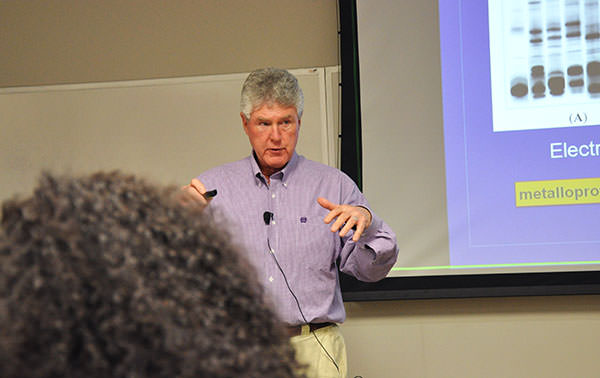[av_gallery ids=’16793,16791,16792,16795,16794′ style=’thumbnails’ preview_size=’portfolio’ crop_big_preview_thumbnail=’avia-gallery-big-crop-thumb’ thumb_size=’portfolio’ columns=’5′ imagelink=’lightbox’ lazyload=’avia_lazyload’]
[av_heading tag=’h3′ padding=’10’ heading=’Alumnus, antivenin developer speaks to med students, residents about snakebites‘ color=” style=’blockquote modern-quote’ custom_font=” size=” subheading_active=” subheading_size=’15’ custom_class=”][/av_heading]
[av_textblock size=” font_color=” color=”]
By Kimberly Florence
Treating snakebites is not as difficult as some might think, said Dr. John Sullivan, an alumnus of The University of Alabama Family Medicine Residency, who gave a lecture on snake venom poisoning on Nov. 11 at the UA College of Community Health Sciences.
The lecture was part of the Dean’s Hour series, a monthly forum for medical students created by the College to raise students’ awareness of community health issues. Residents were also invited to attend.
Sullivan, who is a researcher and clinician at The University of Arizona, graduated from the Residency, which is operated by the College, in 1978. He is well-known for his work in toxicology, including the development of a rattlesnake bite antivenom serum, as well as development of medication container features to prevent tampering following seven Tylenol-related deaths in Chicago in 1982 that were the result of product tampering.
His lecture, titled “Envenomated,” covered venom toxicity along with snake and human factors that affect the impact of snakebites. He also covered environmental grading and his development of CroFab, an antivenin treatment for rattlesnake bites.
“The key to treatment is simply understanding what’s going on,” said Sullivan.
There are three categories for classifying the effects of a snakebite, said Sullivan: local tissue effects, which are identified by pain and inflammation; hematologic effects, which result in cell damage and capillary leakage; and neurotoxic effects, which are the most dangerous and can lead to weakness and dysphonia.
“The severity of a snakebite is determined by many different factors such as the type of snake, location of the bite and the age and size of the snake,” Sullivan said. “Bites to the face, hand and children are more severe.”
Sullivan said that the bigger the snake, the “harder they hurt when they hit.”
“But I am afraid of smaller snakes, because think about it this way—if you’re a small child you’re more terrified when someone grabs you than if you’re a big adult,” he said. “Snakes are the same way. Small snakes are likely to bite more and release all of their venom in a single bite.”
When Sullivan first became interested in snakebites and poisons, he noted that the commonly used antivenin therapy caused a high rate of acute adverse reactions in patients. Witnessing these severe reactions in his patients spurred him to develop a new antivenin therapy.
Sullivan’s research, which began in the 1980s, lead to the development of CroFab, which consists of a purified immunoglobulin G. After undergoing several clinical trials during the 1990s, CroFab received FDA approval in 2000.
CroFab is used to halt local effects at the site of the bite, resolve systematic effects and reduce coagulation abnormalities. It has been the primary treatment for envenomation for the past 16 years.
[/av_textblock]
